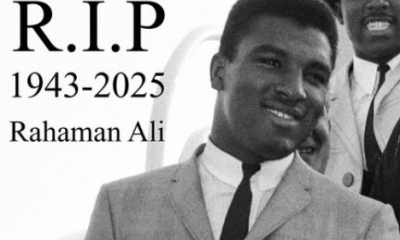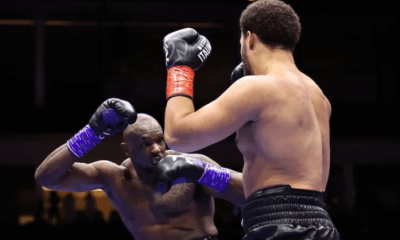Articles of 2007
A Combined 52 Boxers and MMA fighters Failed California Drug Tests in 2006
With mandatory steroid testing poised to begin in March, a California state official revealed that 52 professional boxers and mixed martial arts fighters including Cesar Gracie, Hector Camacho Jr., Bas Rutten, Diego Sanchez and Alfonso Gomez failed drug tests last year.
“We’ve got some issues here,” said Armando Garcia, the Executive Officer for the California State Athletic Commission that is currently without appointed members. “You can’t be doing drugs and competing in combative sports.”
Drug tests taken between March and December revealed that various professional boxers ranging from elite fighters such as Gomez of the television reality show “The Contender,” and Gracie, a Brazilian mixed martial artist fighter who took part in the very first show of that nature allowed in California, were found with drug particles in their system.
Previous to 2006, drug testing was only conducted during championship fights. That policy changed last year in January 2006 with random testing added to both boxing and MMA. Beginning in March 2007, all prizefighters will be tested for steroids and drugs. The number of fighters found with positive drug tests in previous years could not be found.
“Can you imagine what will happen if we do testing all of the time?” Garcia asked.
Most of the drug tests of 2006 revealed rampant use of marijuana and some use of benzodiazepines, cocaine and methamphetamines. None of these drugs are allowed for use by a professional prizefighter.
“It sort of mirrored our society,” said Garcia, who was formerly with Florida’s athletic commission before arriving in California more than a year ago. “We want a drug free competition.”
Deaths in professional boxing average 12 a year worldwide, according to Fight Fax, an organization that is recognized universally as the official keeper of boxing statistics. No deaths have occurred in professional mixed martial arts. But both combative sports run a risk of serious injury.
Use of drugs can be extremely dangerous for professional prizefighters.
Dr. Enrique Gonzalez, who’s provided physical tests for boxers in the past, said marijuana stays in person’s blood system anywhere from 10 days to two weeks. He also said that methamphetamines such as speed provide a boost or a hindrance to a user.
“It can be an enhancer for a person that uses it in the ring,” said Gonzalez, whose practice is located in East Los Angeles. “But if a person uses it too much then it can hurt them.”
Marijuana, says Gonzalez, does not provide stimulation but does have a calming effect. However, the senses can be dampened. Combative sports like boxing and MMA rely on quickness and reflexes.
In the world of professional prizefighting, the state of California experiences more boxing shows than any other state in the country. Last year it topped more than 100 fight cards totaling more than $3 million. And with the legalization of mixed martial arts contests in January 2006, the state is enduring an overload of fight shows and has been working diligently to appoint more judges, referees and physicians to cover the increase of events.
“There’s enough adversity in our sport to overcome,” said Dan Goossen, president of Goossen-Tutor Promotions. “This kind of testing is good for boxing.”
No State Athletic Commission
Aside from Garcia and the government staff selected to assist the Commission, no actual commissioner has been appointed to the board for 2007 by Governor Arnold Schwarzenegger nor the state Senate that selects one member. The last board of commissioners termed out last year.
A spokeswoman from the Governor’s office said on Friday Feb. 23, that a new Commission has not been determined and no date has been set to disclose the new members. Schwarzenegger must appoint five new members and the state Senate must choose one.
Meanwhile two advisory meetings have taken place where Garcia tends to issues that still must be addressed such as mixed martial arts ring designs, appointment of fight officials, promoter and matchmaker problems and drug tests.
Mixed Martial Arts
Ironically, in the very first major mixed martial arts show last March 2006, the popular Cesar Gracie fought Frank Shamrock before an estimated 17,000 people at the HP Pavilion and was promptly knocked out in the first round. His urine sample revealed particles of marijuana in his system.
Last July, Rutten, a well-known MMA fighter out of Einhoven, Holland and a veteran of 33 fights worldwide, beat Ruben Villareal in a WFA bout that took place in Los Angeles at the Inglewood Forum. He won by knockout but tested positive for morphine and diphenhydramine; otherwise known as Benadryl commonly used as a sleeping pill.
In December, Diego Sanchez a rising star in the MMA from New Mexico fought in a show at Miramar in San Diego County. He beat Joe Riggs by knockout but later tested positive for marijuana.
Sanchez fights for Ultimate Fighting Championship an organization based in Las Vegas. That organization was contacted but did not comment on Sanchez testing positive for marijuana.
An MMA card featuring Paul Mince and Ty Montgomery in separate bouts resulted in both participants testing positive for marijuana on Sept. 30.
Walnut Creek’s Joe Hurley tested positive twice during the year for marijuana.
Mixed martial arts began in January 2006 after surviving for more than a decade as an underground sport in Native Indian tribal lands where the California Athletic commission has no jurisdiction unless invited.
Now the state is undergoing a rush of shows including MMA events by Ultimate Fighting Championship and other organizations such as Pride from Japan.
But MMA fighters are not alone in testing positive for drugs.
Professional boxers
Many professional boxers ranging from four-round rookies to 10-round main event fighters failed drug tests throughout the year. Famous boxers and anonymous alike tested positive for drug use in 2006.
Hector “Machito” Camacho Jr. the son of Hector “Macho” Camacho a former world champion, fought last September 14 in Northern California and tested positive for marijuana. He fought George Klinesmith in a middleweight bout scheduled for eight rounds. Both Camacho and Klinesmith tested positive for marijuana.
A few weeks earlier, in Sacramento, Alfonso Gomez of the Contender television reality show, met Carson Jones in a junior middleweight bout fought over eight rounds on August 25. Gomez won a tight contest but seemed sluggish during the fight. Later, his test results were deemed positive. Jones, a month later on Oct. 27, in Oroville, lost a 10-round split-decision to Freddy Hernandez. He tested positive for Benzoylecgonine, a major metabolite of cocaine.
Gomez was contacted by phone but amicably declined to comment on the results.
One fighter Hector Martinez was found with marijuana traces in his system on two occasions July 8 and November 30, 2006.
Fines and suspensions
Garcia said all fighters are notified within two weeks of their failed drug tests and are suspended six months and fined at most $2,500. None of the fighters notified appealed the suspension or the fines.
“If they don’t pay the fine they can’t fight again,” Garcia said.
Now comes steroid testing.
Garcia said a steroid testing facility has already been selected. It’s the same company that tests steroids for the Nevada State Athletic Commission that recently stripped Orlando Salido of his IBF featherweight crown for testing positive. It also detected steroid use in Fernando Vargas following his loss to Oscar De La Hoya in 2003.
“We’re going to mirror Nevada,” says Garcia. “It’s very expensive.”
The California State Athletic Commission plans to use the $26,000 in fines for future testing of its combat athletes.
Though professional boxing or MMA do not have a national commission to oversee its participants, there is a movement to bring both into one federal umbrella by Senator John McCain’s boxing reform act.
Every so often one of the fighters attempts to jump in between the cracks.
One female professional boxer Erin Toughill, who is also an MMA fighter, had been knocked out in one round by a boxer in Nevada. She was automatically suspended 60 days. Before that 60 suspension was over, Toughill attempted to fight on an MMA card at San Manuel Casino and had her name plastered on posters and advertisements. The California inspectors immediately notified her that she was still under suspension and could face further punishment.
“Suspensions are nationwide,” said Marc Ratner, who serves as an advisor for UFC and was the former executive director for Nevada State Athletic Commission.
With the surge of MMA fights in California and with boxing enjoying an explosion throughout the state, CSAC is under pressure to keep the lid on fair and safe competition.
“We don’t want you using drugs in California,” says Garcia to all professional prizefighters.
Robert “The Ghost” Guerrero, who recently reclaimed his IBF featherweight title this past weekend in Denmark after losing to Salido who tested positive for steroids, said it plain and simple.
“It’s cheating,” he said.
The California State Athletic Commission plans to use the $26,000 in fines for future testing of its combat athletes.
Though professional boxing or MMA do not have a national commission to oversee its participants, there is a movement to bring both into one federal umbrella by Senator John McCain’s boxing reform act.
Every so often one of the fighters attempts to jump in between the cracks.
One female professional boxer Erin Toughill, who is also an MMA fighter, had been knocked out in one round by a boxer in Nevada. She was automatically suspended 60 days. Before that 60 suspension was over, Toughill attempted to fight on an MMA card at San Manuel Casino and had her name plastered on posters and advertisements. The California inspectors immediately notified her that she was still under suspension and could face further punishment.
“Suspensions are nationwide,” said Marc Ratner, who serves as an advisor for UFC and was the former executive director for Nevada State Athletic Commission.
With the surge of MMA fights in California and with boxing enjoying an explosion throughout the state, CSAC is under pressure to keep the lid on fair and safe competition.
“We don’t want you using drugs in California,” says Garcia to all professional prizefighters.
Robert “The Ghost” Guerrero, who recently reclaimed his IBF featherweight title this past weekend in Denmark after losing to Salido who tested positive for steroids, said it plain and simple.
“It’s cheating,” he said.
-

 Featured Articles3 weeks ago
Featured Articles3 weeks agoThe Hauser Report: Zayas-Garcia, Pacquiao, Usyk, and the NYSAC
-

 Featured Articles3 weeks ago
Featured Articles3 weeks agoOscar Duarte and Regis Prograis Prevail on an Action-Packed Fight Card in Chicago
-

 Featured Articles2 weeks ago
Featured Articles2 weeks agoThe Hauser Report: Cinematic and Literary Notes
-

 Book Review1 week ago
Book Review1 week agoMark Kriegel’s New Book About Mike Tyson is a Must-Read
-

 Featured Articles3 weeks ago
Featured Articles3 weeks agoRemembering Dwight Muhammad Qawi (1953-2025) and his Triumphant Return to Prison
-

 Featured Articles2 weeks ago
Featured Articles2 weeks agoRahaman Ali (1943-2025)
-

 Featured Articles4 days ago
Featured Articles4 days agoMoses Itauma Continues his Rapid Rise; Steamrolls Dillian Whyte in Riyadh
-

 Featured Articles2 weeks ago
Featured Articles2 weeks agoTop Rank Boxing is in Limbo, but that Hasn’t Benched Robert Garcia’s Up-and-Comers












